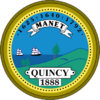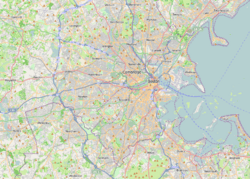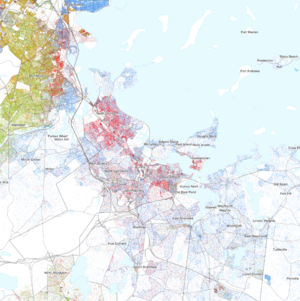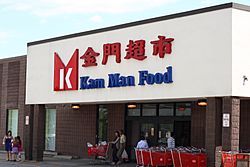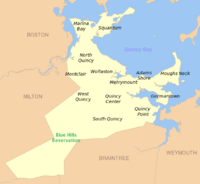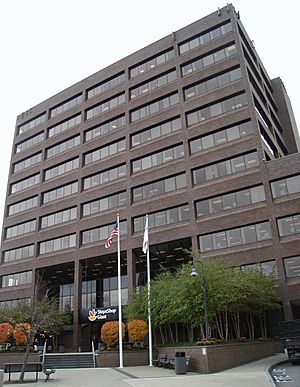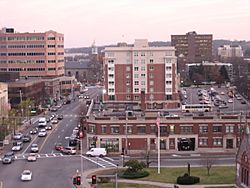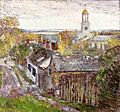Quincy, Massachusetts facts for kids
Quick facts for kids
Quincy, Massachusetts
|
|||
|---|---|---|---|

Quincy Center in 2018
|
|||
|
|||
| Nickname(s):
"City of Presidents"
|
|||
| Motto(s): | |||
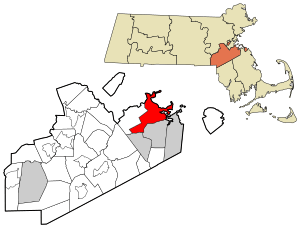
Location of Quincy in Norfolk County, Massachusetts
|
|||
| Country | |||
| State | |||
| County | Norfolk | ||
| Region | New England | ||
| Settled | 1625 | ||
| Incorporated (town) | 1792 | ||
| Incorporated (city) | 1888 | ||
| Named for | John Quincy | ||
| Government | |||
| • Type | Mayor–council | ||
| Area | |||
| • Total | 26.91 sq mi (69.69 km2) | ||
| • Land | 16.57 sq mi (42.92 km2) | ||
| • Water | 10.33 sq mi (26.77 km2) | ||
| Elevation | 30 ft (9 m) | ||
| Highest elevation | 517 ft (158 m) | ||
| Lowest elevation | 0 ft (0 m) | ||
| Population
(2020)
|
|||
| • Total | 101,636 | ||
| • Density | 6,132.63/sq mi (2,367.87/km2) | ||
| Time zone | UTC−5 (Eastern) | ||
| • Summer (DST) | UTC−4 (Eastern) | ||
| ZIP Code |
02169–02171
|
||
| Area codes | 617 and 857 | ||
| FIPS code | 25-55745 | ||
| GNIS feature ID | 0617701 | ||
Quincy (pronounced KWIN-zee) is a city in Norfolk County, Massachusetts, United States. It is the biggest city in the county. Quincy is part of the Greater Boston area, located just south of Boston. In 2020, its population was 101,636, making it the seventh-largest city in Massachusetts.
Quincy is known as the "City of Presidents." This is because two U.S. presidents were born here: John Adams and his son, John Quincy Adams. Also, John Hancock, the first person to sign the Declaration of Independence and a governor of Massachusetts, was born in Quincy.
The area was first settled in 1625. It was briefly part of Dorchester before becoming the North Precinct of Braintree in 1640. In 1792, Quincy became its own town. It was named after Colonel John Quincy, who was the grandfather of Abigail Adams. John Quincy Adams was also named after him. Quincy officially became a city in 1888.
For more than 100 years, Quincy was famous for its granite quarrying industry. The city was also home to the Granite Railway, which was the first commercial railroad in the United States. Building ships at the Fore River Shipyard was another important part of Quincy's economy. In the 1900s, two well-known restaurant chains, Howard Johnson's and Dunkin' Donuts, started in Quincy.
Contents
- Exploring Quincy's Past: A Look at Its History
- Quincy's Geography and Natural Features
- Understanding Quincy's Population: Demographics
- Quincy's Unique Neighborhoods
- Quincy's Economy: How the City Makes a Living
- Education in Quincy: Schools and Colleges
- Getting Around Quincy: Transportation
- Sports in Quincy
- Famous People from Quincy
- Images for kids
- See also
Exploring Quincy's Past: A Look at Its History
Early Settlements and the Revolution
The path that became the Old Coast Road, connecting Boston to Plymouth through Quincy and Braintree, was originally a Native American trail.
Before English colonists arrived, the Massachusett leader Chickatawbut lived on a hill called Moswetuset Hummock. This spot was near the mouth of the Neponset River, close to what is now Squantum. In 1621, Myles Standish from Plymouth Colony visited with Squanto, a Native American guide.
Four years later, in 1625, Captain Richard Wollaston led a group to set up a trading post. They chose a small hill near the south shore of Quincy Bay. This area was good for farming because Chickatawbut's group had already cleared many trees. The Native Americans called the area Passonagessit, meaning "Little Neck of Land." The settlement was named Mount Wollaston after Captain Wollaston. He soon left for Virginia.
The Wollaston neighborhood in Quincy still carries Captain Wollaston's name today. After Wollaston left, Thomas Morton took charge. Morton often disagreed with the Plymouth settlement. He renamed the post Ma-re-Mount, meaning "Hill by the Sea." In 1627, Morton was arrested by Standish. He was sent back to England but returned and was arrested again by Puritans the next year. The area of Quincy now called Merrymount is where the first English settlement was. It gets its name from Morton's playful name.
The area became part of Dorchester in 1630. It was briefly connected to Boston in 1634. In 1640, it became part of Braintree. The modern border of Quincy began to form in 1708 as the North Precinct of Braintree.
Quincy After the American Revolution
After the American Revolution, Quincy officially became a separate town in 1792. It was named after Colonel John Quincy, who was the grandfather of Abigail Adams. Quincy became a city in 1888. Quincy, Massachusetts, is unique because its residents say "KWIN-zee," unlike other cities named Quincy in the U.S.
In 1845, the Old Colony Railroad opened. This railroad made Quincy easily reachable from Boston. It was the start of people moving from cities to suburbs. Quincy's population grew by over 50 percent in the 1920s.
Quincy is known for several "firsts." The Granite Railway was the first commercial railroad in the United States. It was built in 1826 to move granite from a Quincy quarry. The granite was taken to the Neponset River in Milton. From there, it traveled by boat to build the Bunker Hill Monument in Charlestown. Quincy granite became famous across the country. Stonecutting became the city's main business. Quincy also had the first iron furnace in the U.S., the John Winthrop Jr. Iron Furnace Site, from 1644 to 1653.
In the 1870s, the city gave its name to the Quincy Method. This was an important way of teaching developed by Francis W. Parker. He was Quincy's superintendent of schools. Parker believed in progressive education. He used his ideas in Quincy's schools, which were not doing well. Four years later, a state study found that Quincy's students were doing great. Many Quincy teachers were hired by schools in other states, spreading the Quincy Method far and wide.
Quincy was also an important place for shipbuilding. Many sailing ships were built here. This included the Thomas W. Lawson, the only seven-masted schooner ever built. The Fore River area became a shipbuilding hub in the 1880s. Thomas A. Watson, who helped Alexander Graham Bell invent the telephone, founded the Fore River Shipyard. Many famous warships were built there. These included the aircraft carrier USS Lexington (CV-2), the battleships USS Massachusetts (BB-59) and USS Nevada (BB-36), and USS Salem (CA-139). The USS Massachusetts (BB-59) is now a museum ship at Battleship Cove. The USS Salem (CA-139) is the world's last all-gun heavy warship. It is still at Fore River as part of the United States Naval Shipbuilding Museum.
Quincy was also a pioneer in aviation thanks to Dennison Field. Located in Squantum, it was one of the world's first airports. Amelia Earhart helped develop it. In 1910, it hosted the Harvard Aero Meet, the second air show in America. It later became a Naval Air Station for the Navy until the 1950s. The Massachusetts Army National Guard also had a presence in the city at the Kelley Armory in Wollaston.
The Howard Johnson's and Dunkin' Donuts restaurant chains both started in Quincy. The Celtic punk band Dropkick Murphys formed in Quincy's Wollaston neighborhood in 1996. Quincy also has the longest-running Flag Day parade in the United States. This tradition began in 1952.
Quincy's Geography and Natural Features
Quincy borders Boston to the north, separated by the Neponset River. To the west is Milton. Randolph and Braintree are to the south. Weymouth (separated by the Fore River) and Hull are to the east.
Quincy Bay is within the city limits to the northeast. It is part of Boston Harbor and Massachusetts Bay. Quincy has several beaches, including Wollaston Beach along Quincy Shore Drive. Wollaston Beach is the largest beach in Boston Harbor. Quincy's area includes Hangman Island, Moon Island, Nut Island (now a peninsula), and Raccoon Island. These are all part of the Boston Harbor Islands National Recreation Area.
The city covers about 26.9 square miles. About 16.8 square miles are land, and 10.1 square miles are water. This means about 37.60% of the total area is water.
Even though Quincy is mostly an urban area, a large part of its land is undeveloped. About 2,485 acres, or 23 percent, are within the Blue Hills Reservation. This is a state park managed by the Massachusetts Department of Conservation and Recreation. This natural area covers the southwestern part of Quincy. It includes the city's highest point, Chickatawbut Hill, which is 517 feet high. Other hills in Quincy include Forbes Hill in Wollaston and Presidents Hill in Quincy Center.
Understanding Quincy's Population: Demographics
In 2020, Quincy had 101,636 people and 46,789 households. This made it the eighth-largest city in Massachusetts. The population density was about 6,137.6 people per square mile. There were 51,156 housing units in the city.
The racial makeup of Quincy in 2020 was 56.2% White (not Hispanic), 6.4% African American, 0.1% Native American, and 28.9% Asian. The Asian population included 15.6% Chinese, 3.2% Vietnamese, and 2.6% Indian. About 5.3% of the population was of two or more races. Hispanic or Latino people made up 5.4% of the population.
In 2000, 33.5% of residents had Irish ancestry, 12.7% Italian, and 5.0% English. Most people (58.1%) spoke only English at home. Other languages spoken included Chinese or Mandarin (8.0%), Cantonese (2.6%), Spanish (1.9%), Vietnamese (1.5%), and Italian (1.3%).
Of the households, about 56.6% were married couples living together. The average household size was 2.2 people. Most people (84.3%) had lived in the same house for at least a year.
The population's age distribution showed 14% were under 18 years old. About 66.2% were between 18 and 64, and 19.9% were 65 or older. The average age was 40.8 years.
The median income for a household in Quincy was $90,668. This means half of the households earned more than this, and half earned less. The per capita income for the city was $53,082. About 9.8% of the population lived below the poverty line. This included 15.2% of those under 18 and 11.1% of those 65 or older.
Quincy's Growing Asian Community
As of 2010, Quincy has the highest number of Asian residents per person in Massachusetts. In 2003, about 66% of the Asian population in Quincy was ethnic Chinese. This makes Quincy one of the largest Chinese communities in the state. There is also a community of people from East Indian origins. Many of them work in information technology and other skilled jobs. A growing number of people with Vietnamese origins also live in Quincy. It is estimated that nearly 4,000 Vietnamese people live in the city.
In 1980, there were 750 people of Asian origin in Quincy. Most Asian immigrants in the 1980s came from Hong Kong and Taiwan. By 1990, Quincy had 5,577 people of Asian origin. This number grew to 13,546 in 2000. About 9,000 of them were ethnic Chinese. The East Indian population grew by 688%, making it the fastest-growing Asian group in Quincy. Around 2003, most Asian immigrants were coming from Fujian instead of Hong Kong and Taiwan. At that time, Quincy had more Asian residents than Boston's Chinatown. The total Asian population increased by 64% in the next decade, reaching 22,174 in 2010. Quincy's Chinese population grew by 60% during this time.
Historically, Quincy residents would travel to shops in Chinatown, Boston. But by 2003, Asian shopping centers were built in Quincy. Kam Man Food, a supermarket chain from New York City, opened a store in Quincy. In February 2017, City Councilor Nina Liang suggested making Quincy a "Sanctuary City." This idea was voted down by the City Council. Quincy has an estimated 8,000 undocumented residents. It has the 11th-highest number of immigrants in Massachusetts overall.
In 2000, about 50% of Asian residents in Quincy owned their homes. Many who rented were saving money to buy a house. Sixty-five percent of Chinese residents owned homes, while only 10% of East Indians did. In 2003, more than 2,500 Asian Americans in Quincy were registered to vote. This was almost 25% of eligible Asian voters in the city.
In the 1980s, the city faced challenges with community relations, especially with new residents from Southeast Asia and China. At that time, the Quincy Police Department did not have any AAPI police officers. This made it hard for the Asian-American community to trust the police. Over time, the City worked to connect with its Asian-American communities. They created programs to share immigrant cultures. This helped the wider community learn about their new neighbors and encouraged everyone to get along. By 2003, the Quincy Police Department had made it a priority to have a more diverse police force, hiring many Asian-American officers.
In 2003, Quincy Asian Resources Inc. planned to start a newsletter for Asian residents. In 2011, Boston Chinatown Neighborhood Center, Inc. (BCNC) began offering services in Quincy.
Quincy's Unique Neighborhoods
Quincy has many different neighborhoods. Each has its own history and feel.
- Adams Shore was once a summer resort area. Now, people live there all year round.
- Germantown was a planned factory community started in the 1750s. It was meant to encourage German immigration. Today, it is a busy residential area with public housing.
- Houghs Neck is a peninsula in the northeast. It was named after Atherton Hough, who got the land in 1636 for a farm. Hough's Neck has many Irish-American residents.
- Marina Bay is a residential and commercial area. It was built in the 1980s on the site of the old Naval Air Station Squantum. It has high-rise condominiums, restaurants, and a large marina.
- Merrymount is mostly a residential neighborhood. It is also where Quincy's first settlement was located.
- Montclair is in the northwestern part of the city. It borders the town of Milton.
- North Quincy is a residential and commercial area. It has a large Asian-American population. The community is known for its diverse small businesses. It is also home to North Quincy High School, one of the city's largest high schools.
- Quincy Center is the main commercial and government area of the city. You can find City Hall, the Thomas Crane Public Library, the United First Parish Church, and many offices and homes here.
- Quincy Point is a busy residential area east of Quincy Center. It has businesses along Quincy Avenue and Southern Artery. The Fore River Shipyard is also located here.
- South Quincy is a residential and commercial area. It borders the town of Braintree. It includes the Crown Colony office park and Faxon Park, a 66-acre wooded protected space.
- Squantum is a peninsular area and the northernmost part of Quincy. It was once a popular summer resort. Now, it is a year-round residential area known for its close-knit community. It offers several beaches and Squantum Point Park. Squantum has many Irish-American residents.
- West Quincy is a residential and commercial area with easy access to Interstate 93. It is the site of several old granite quarries, now the Quincy Quarries Reservation. It also has the Granite Railway, the first commercial railway in the United States.
- Wollaston is named after Captain Richard Wollaston, who led Quincy's first settlers. It was an early commuter town for Boston workers. Now, it is a busy residential and commercial area. It includes the Eastern Nazarene College campus.
Quincy's Economy: How the City Makes a Living
Historically, Quincy was known for manufacturing and heavy industry. In the 1800s, granite quarrying was the main job. In the 1900s, shipbuilding at Fore River Shipyard became very important. In recent years, Quincy's economy has shifted. Now, many large employers are in professional and service industries.
Quincy is home to the main offices of several companies. These include Boston Financial Data Services, the Stop & Shop supermarket chain, Arbella Insurance Group, and The Patriot Ledger. The Patriot Ledger publishes the largest regional newspaper for the South Shore.
Other big companies with offices in Quincy are State Street Corporation, Blue Cross Blue Shield of Massachusetts, Harvard Pilgrim Health Care, and Boston Scientific. TACV, the national airline of Cape Verde, has its U.S. office in Quincy. Icelandair also has its North American headquarters here.
Education in Quincy: Schools and Colleges
Quincy has many schools and colleges, both public and private. These include a Montessori school, Catholic academies, and a private college-preparatory school. Eastern Nazarene College, a private liberal arts college, is in the process of closing after the 2024-2025 school year. Quincy College, a public community college, is also in the city. Quincy has two public high schools, five public middle schools, and 12 public elementary schools.
In the 1800s, Quincy was a leader in new ways of teaching. The Quincy Method was developed by Francis W. Parker. He was the superintendent of schools in Quincy. Four years after he started this method, a state study found that Quincy students were excellent at reading, writing, and spelling. They also ranked fourth in their county for math.
Colleges and Higher Learning
Eastern Nazarene College is a private college located in Wollaston Park. It moved to Quincy in 1919. The college was founded in 1900 in New York. In June 2024, the college announced plans to close by the end of the 2024-2025 school year. The future of its campus is not yet known.
Quincy College is a community college in Quincy Center. It is run by the City of Quincy. This is unusual because most community colleges in Massachusetts are run by the state. Quincy College is one of only two colleges in the United States organized this way.
Public Schools for Kids and Teens
Quincy Public Schools manages public education from preschool through high school. The system includes one early childhood center, eleven elementary schools, five middle schools, and two high schools.
- Public High Schools
- North Quincy High School
- Quincy High School
- Public Middle Schools
- Atlantic
- Broad Meadows
- Central
- Point Webster
- South-West (formerly Reay E. Sterling)
- Public Elementary Schools
|
|
|
Private and Other Schools
Private and alternative schools for children from preschool to 8th grade include Quincy's three Catholic schools: Sacred Heart, St. Ann, and St. Mary. In 2010, the Archdiocese of Boston combined these three schools to form the Quincy Catholic Academy. It opened at the site of the former Sacred Heart school.
The Woodward School for Girls, which opened in 1894, is an independent school. It offers a college-preparatory education for girls in grades 6–12.
The Adams Montessori School is available for children from preschool through elementary school age.
Public Libraries
The Thomas Crane Public Library is the main library in Quincy. It is part of the regional Old Colony Library Network.
Learning Chinese in Quincy
Several Chinese community groups in Quincy have offered after-school and weekend classes. These classes teach Mandarin and Cantonese to local youth. The Quincy Chinese Language School and The Chung Yee School are no longer open. In 2016, The South Shore Chinese Language School began offering popular weekend classes in Mandarin and Cantonese for children ages 5 and up at the Quincy YMCA.
Getting Around Quincy: Transportation
Quincy is part of Greater Boston, so it has good access to transportation. State highways and the Interstate system connect the area to Boston's airport, port, and other transport hubs. Because it's close to Boston, Quincy is also connected to the regional subway system. This system is run by the Massachusetts Bay Transportation Authority (MBTA), known as "The T."
Quincy has four subway stops on the MBTA's Red Line: North Quincy Station, Wollaston Station, Quincy Center Station, and Quincy Adams Station. Commuter rail service also runs from Quincy Center. Both subway and commuter rail services go to South Station in Boston. From there, you can connect to other MBTA Commuter Rail lines and Amtrak trains. Buses are also available in Quincy, including private lines and several MBTA lines. Most MBTA bus routes go through the Quincy Center station. This station is the main hub for all MBTA bus lines south of Boston.
Highways and Main Roads
Interstate 93 and U.S. Route 1 run together through Quincy from south to north. This route goes around the southern part of the Blue Hills Reservation. This section of I-93 and US 1 used to be part of Route 128. The highway travels through a wooded area of the Reservation. It enters Quincy fully just past Exit 5 and then goes into Braintree as it nears the Braintree Split. This is where Massachusetts Route 3 joins the highway. This intersection is very busy, with about 250,000 to 275,000 vehicles passing through daily. It is the main way to get from Boston to the South Shore and Cape Cod.
As Route 3 joins I-93 and US 1 at the Braintree Split, the three roads go north together toward Boston. They travel around the eastern part of the Blue Hills Reservation, entering West Quincy as the Southeast Expressway. This expressway provides exits for West Quincy at Exit 8 (Furnace Brook Parkway) and Exit 9 (Bryant Avenue/Adams Street) before going into Milton. The Furnace Brook Parkway exit also leads to the Quincy Quarries Reservation.
Important state highways in Quincy include: Route 3A, which goes from Weymouth to Dorchester. Route 28, which travels from Randolph to Milton through a remote part of the Blue Hills Reservation. And Route 53, which enters from Braintree as Quincy Avenue.
Quincy also has two other important parkways managed by the Massachusetts Department of Conservation and Recreation. Furnace Brook Parkway travels east from I-93 through the city center. It goes from West Quincy to Quincy Center and Merrymount at Quincy Bay. There, it meets Quincy Shore Drive. Quincy Shore Drive goes north along the shore of Quincy Bay through Wollaston and into North Quincy. Much of it runs next to Wollaston Beach.
Other important city streets include Hancock Street, which goes north from Quincy Center to Dorchester. Washington Street enters the city from Weymouth and continues to Quincy Center. Quincy Avenue, Southern Artery, and Newport Avenue are also busy streets. Adams Street heads west from Quincy Center to Milton. West and East Squantum Streets are in the Montclair and North Quincy neighborhoods.
Airport Access
Boston's Logan International Airport is easy to reach from Quincy. You can take the MBTA Red Line and connect at South Station. You can also take the MBTA commuter boat (see below) or drive using Interstate 93.
Public Transit and Commuter Boats
Subway service is available on the Red Line of the MBTA from four stations in Quincy: North Quincy, Wollaston, Quincy Center, and Quincy Adams. Commuter rail service also runs from Quincy Center. Both services go to South Station in Boston. From there, you can connect to other MBTA Commuter Rail lines and Amtrak intercity trains. Buses are also available for transportation in Quincy. Most MBTA routes go through the Quincy Center station. This is the main hub south of Boston for all MBTA bus lines.
Quincy used to be a major stop for the commuter boat system. These boats crossed Boston Harbor to places like Long Wharf, Hull, and Logan Airport. The boats docked at the Fore River Shipyard in Quincy Point. Service ended in October 2013 after damage to the dock.
Sports in Quincy
Quincy has had some professional sports teams. The Quincy Chiefs, a basketball team, played one season in 1977–1978. Quincy's professional baseball team, the Shipbuilders, played in the New England League in the 1930s and 1940s. The Boston Minutemen, a soccer team, played their final season at Veterans Memorial Stadium in 1976.
The Real Boston Rams, a soccer team, played at Veterans Memorial Stadium from 2014 to 2015. In 2019, the Boston Cannons, a professional men's field lacrosse team, moved their home stadium to Veterans Memorial Stadium. They played two seasons there. The New England Free Jacks, a Major League Rugby team, moved to Veterans Memorial Stadium in 2021.
Quincy has also had several football teams in the semi-pro Eastern Football League. The current team, the Quincy Militia, started in 2009. They play home games at Veterans Memorial Stadium. An earlier team, the Quincy Giants, played in the late 1960s and early 1970s.
Eastern Nazarene College has college sports teams called the "Lions." They play in the D-III Commonwealth Coast Conference. Games are played at Bradley Field and the Lahue Physical Education Center on campus, or at Adams Field and Veterans Memorial Stadium.
Quincy's high school sports teams are in the Patriot League. The "Raiders" are from North Quincy High School, and the "Presidents" are from Quincy High School. They are rivals. Quincy also hosted the youth baseball Babe Ruth League World Series in 2003, 2005, and 2008. High school baseball and Babe Ruth League games are played at Adams Field. High school football is played at Veterans Memorial Stadium.
Famous People from Quincy
- Abigail Adams, wife of President John Adams
- John Adams, second President of the United States
- John Quincy Adams, sixth President of the United States
- John Hancock, a founding father who signed the Declaration of Independence
- Ruth Gordon, Oscar-winning actress
- Dick Dale, famous surf guitarist
- Amelia Earhart, aviation pioneer (lived in Squantum)
- Howard Deering Johnson, founder of the Howard Johnson's chain
- William Rosenberg, founder of Dunkin' Donuts
- Priscilla Chan, philanthropist and wife of Mark Zuckerberg
- Peter Del Vecho, Oscar-winning producer of Frozen
- Joseph Dunford, former Chairman of the Joint Chiefs of Staff
- Lee Remick, Oscar-nominated actress
- Charles Sweeney, Air Force general, pilot for the Nagasaki nuclear attack
- Robert Burns Woodward, Nobel Prize-winning chemist
Images for kids
-
President John Adams' birthplace.
-
"Peacefield", residence of four generations of the Adams family.
-
The Josiah Quincy House in Wollaston Park.
-
Tombs of Presidents John Adams and John Quincy Adams and their wives, in a family crypt beneath the United First Parish Church in Quincy Center.
-
View of Marina Bay and Boston across Quincy Bay from Wollaston Beach.
-
USS Salem (CA-139), site of the United States Naval Shipbuilding Museum.
-
The Massachusetts National Guard's Kelley Armory in Wollaston
See also
 In Spanish: Quincy (Massachusetts) para niños
In Spanish: Quincy (Massachusetts) para niños



